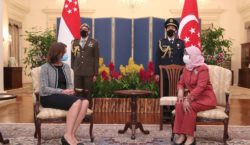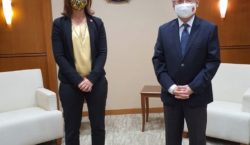
JydskeVestkysten recently published the latest op-ed piece in the summer series from Danish Ambassadors around the world. This time it’s written by the Ambassador of Denmark to Singapore Sandra Jensen Landi and she writes about how the spread of the Delta variant which came as a surprise to Singapore, has postponed national day celebrations.
The Ambassador writes:
The jets circled over the city in formations. The skydivers performed test jumps. The podium was finished. We all looked forward to celebrating Singapore’s National Day on 9 August with a bang. Singapore was to be commended for coping remarkably with the pandemic, and we were meant to hear the Prime Minister talk about new times free from the shadow of the pandemic. Then the delta variant made its way in and now the party is postponed.
So far, the National Day celebrations have been postponed until the end of August, and the city-state has been shut down until 18 August. Restaurants are closed and we are only allowed to gather in groups of two.
Authorities hope it provides enough time to get the population vaccinated. They calculate that at least two-thirds must be fully vaccinated before the restrictions are eased, and 80 percent vaccinated before the country can be opened. To get the pace up, the booking system has been dropped, so you just walk in to get vaccinated. Out of a population of 5.7 million, over 65 percent are now fully vaccinated.
No one apparently knows how the delta variant made its way into the closed country at the beginning of summer. When a fully vaccinated nurse without symptoms spread the virus, it became clear that the enemy was aggressive. Two clusters of infection, in particular, caused the numbers to explode in mid-July: an outbreak at a fishing port with a large network of markets and restaurants, and an outbreak in a group of bars where guests pretend to come for karaoke but in reality come to get paid attention from the hostesses. In just a few days, infection rates rose from less than ten to more than 150 cases a day. A shutdown was launched.
Singapore is honored as one of the world’s best countries to deal with the pandemic. From the summer of 2020 until May this year, the country was a largely infection-free bubble. We have worn facemasks and kept our distance, but in everyday life, we could still occasionally forget that a pandemic was even going on.
The schools were open and we could go out to eat as long as no more than eight people were sitting together at a table. While the second wave stopped Christmas shopping in Europe, we went shopping in Singapore’s countless shopping malls on Orchard Road. Lots of people with glowing credit cards.
Singapore’s preferences for control, systems and, science have been reflected in pandemic management. The biggest building blocks in the bulwark have been contact tracking, quarantine, and travel restrictions. Authorities quickly realized that none of us can remember where we were two weeks ago. Therefore, SafeEntry was introduced with QR codes, which we had to scan at all inputs and outputs. It was replaced in the spring by TraceTogether, which via an app on the phone or a token in my pocket tracks who I am close to. So if I get covid-19, few people can clear my full network in a day. They are then all quarantined and tested.
To keep the infection out, the borders have long been closed. It is difficult to be allowed to enter, even as a permanent resident, and after entry, you must be in a two-week self-paid quarantine at a hotel. For the authorities, the system has worked. Despite demands for negative PCR testing before entry, they have found between five and 50 infected among the entrants almost every day, and the flow of entrants has been adjusted depending on infection pressure elsewhere.
But it is expensive to be a closed country when you make a living from being an international hub for companies and a shopping mecca for the 18-19 million tourists who usually visit the country every year. In 2020, GDP thus shrank by 5.4 percent. Although Singapore has solid savings, the country would rather not run with that kind of overdraft for several years in a row.
Singapore’s dilemma is that the population expects low risk, and neighboring countries are experiencing explosive infection rates. High infection rates create unrest after intense focus on keeping the infection down for a year and a half, and it takes time to get voters used to count in patients in intensive care units instead of infection rates. But the population is tired of homework, the economy is bleeding, companies are longing to travel, the international airport is a ghost town, and reopening elsewhere is putting Singapore’s status as a hub under pressure. How long can you wait before jobs move elsewhere?
Singapore is betting that the vaccines are a durable lifeline for a controlled reopening. Singapore stands out from other countries in the region by having come a long way in vaccinating the population. There is a large influx of vaccines, also among 12-15-year-olds, but the oldest citizens have had a harder time getting to the vaccination centers. They have not seen themselves as being at risk and they do not want to travel.
But the prime minister is appealing for their community spirit to overcome the skepticism. They are the pioneers who are celebrated on National Day for having worked hard to build Singapore’s economic success. Now they need to step in again and secure Singapore’s economic future. The party must start.
All articles from this summer’s series from Danish ambassadors around the world can be read on Avisen Danmark’s e-newspapers.





